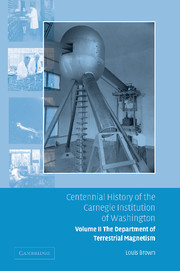Book contents
- Frontmatter
- Contents
- Foreword by Richard A. Meserve
- Preface
- 1 Establishment
- 2 Cruises and war
- 3 Expeditions
- 4 Measurements: magnetic and electric
- 5 The Fleming transition
- 6 The last cruise
- 7 The magnetic observatories and final land observations
- 8 The ionosphere
- 9 Collaboration and evaluation
- 10 The Tesla coil
- 11 The Van de Graaff accelerator
- 12 The nuclear force
- 13 Fission
- 14 Cosmic rays
- 15 The proximity fuze and the war effort
- 16 The Tuve transition
- 17 Postwar nuclear physics
- 18 The cyclotron
- 19 Biophysics
- 20 Explosion seismology
- 21 Isotope geology
- 22 Radio astronomy
- 23 Image tubes
- 24 Computers
- 25 Earthquake seismology
- 26 Strainmeters
- 27 The Bolton and Wetherill years
- 28 Astronomy
- 29 The solar system
- 30 Geochemistry
- 31 Island-arc volcanoes
- 32 Seismology revisited
- 33 Geochemistry and cosmochemistry
- 34 The Solomon transition
- 35 The support staff
- 36 Epilogue
- Notes
- Index
8 - The ionosphere
Published online by Cambridge University Press: 06 January 2010
- Frontmatter
- Contents
- Foreword by Richard A. Meserve
- Preface
- 1 Establishment
- 2 Cruises and war
- 3 Expeditions
- 4 Measurements: magnetic and electric
- 5 The Fleming transition
- 6 The last cruise
- 7 The magnetic observatories and final land observations
- 8 The ionosphere
- 9 Collaboration and evaluation
- 10 The Tesla coil
- 11 The Van de Graaff accelerator
- 12 The nuclear force
- 13 Fission
- 14 Cosmic rays
- 15 The proximity fuze and the war effort
- 16 The Tuve transition
- 17 Postwar nuclear physics
- 18 The cyclotron
- 19 Biophysics
- 20 Explosion seismology
- 21 Isotope geology
- 22 Radio astronomy
- 23 Image tubes
- 24 Computers
- 25 Earthquake seismology
- 26 Strainmeters
- 27 The Bolton and Wetherill years
- 28 Astronomy
- 29 The solar system
- 30 Geochemistry
- 31 Island-arc volcanoes
- 32 Seismology revisited
- 33 Geochemistry and cosmochemistry
- 34 The Solomon transition
- 35 The support staff
- 36 Epilogue
- Notes
- Index
Summary
In December 1901 Guglielmo Marconi received at St. John's, Newfoundland, a wireless telegraph transmission of the letter “S” from his powerful station in Cornwall, England. Following Hertz's discovery of electromagnetic waves in 1887 physicists had concentrated their efforts on verifying that these waves had the properties of optical light, which precluded any thought of receiving them at distances beyond the horizon. Marconi had proceeded along a different path by alone having seen the communication possibilities between ships using waves much longer than Hertz had used. His company prospered, and his experience with waves of hundreds of meters demonstrated that they were being received at distances beyond the horizon.
The St. John's transmission was doubted in many quarters but was soon verified, confounding physics theory. An explanation came independently from two electrical engineers: there must be a conducting layer at the top of the atmosphere. Oliver Heaviside inserted the idea in the article he wrote on telegraphy for the Encyclopaedia Britannica (10th edition, 1902). Arthur Edwin Kennelly, a Philadelphia engineer, had published the same observation more conventionally and somewhat earlier.
For reasons other than transmission distance, wireless telegraphy was restricted for the first two decades of the century to those long wavelengths. Owing to the wide bandwidths required by the spark equipment then in use, the limited range of frequencies available in this region of the spectrum was quickly gobbled up by government and commercial traffic, and amateurs were given the useless but enormous short-wave band.
- Type
- Chapter
- Information
- Publisher: Cambridge University PressPrint publication year: 2005



